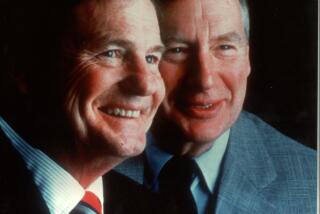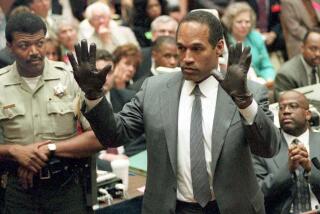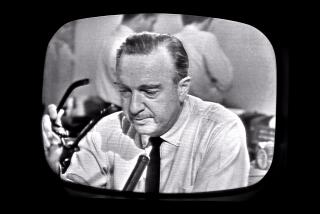TV Technology: A Split Personality
Itâs Dec. 21, Day 2 of the U.S. invasion of Panama. President Bush is holding a press conference, and the networks are covering it live.
Bush is typically in command, âhandlingâ reporters, even joshing with them. Affable, relaxed and fast-reacting, here is a man confident of his ability to spar with and finesse the Washington press corps without suffering even a bruise.
But then something happens that Bush canât control. Suddenly the television picture is split and millions of viewers are seeing side-by-side images that clash.
While half the screen continues to show a smiling, lighthearted Bush bantering with the press, the other half shows the flag-draped coffins of U.S. soldiers killed in Panama being solemnly carried from a jet transport at a Delaware Air Force base.
The split-screen coverage makes the President appear frivolous, almost to the point of seeming to make light of these servicemen who died carrying out his policy.
Bush has no idea that on three networks--NBC being the exception--he is occupying only part of a picture. Later, when he finds out what has happened, he is justifiably angry.
Did ABC, CBS and CNN split the screen to make the President look bad? Unlikely.
Networks may be a little bit thick, but theyâre not masochists. They know that appearing to unfairly bash, embarrass or upstage a seemingly triumphant President--even if Bush isnât as beloved as Ronald Reagan--will inevitably create a backlash. The President may suffer a short-term loss of face, but the news divisions will be the long-term losers in having ultimately reinforced the belief that theyâre unpatriotic troublemakers who undercut the government with their skepticism.
They were hardly skeptical this time, however. In fact, early coverage of the Panama invasion showed just the opposite: how docile and unquestioning the networks can be in reporting, interpreting and examining the fundamental premise of a military incursion given overwhelming domestic support. It almost seemed that boring old Bush was being subconsciously rewarded by the appreciative networks for finally doing something that provided conflict and dramatic television.
No, the split-screen incident does not represent TV irreverence run amok.
It symbolizes TV technology run amok.
By taping the casket sequence and showing it later, NBC lost nothing. For the others, just having the capacity to provide multiple live pictures simultaneously became justification for doing it.
Man preceded technology, but now itâs technology thatâs evolving fastest. TV technology is extraordinary, all right, but sometimes dangerously so, developing at a pace swifter than our capacity to consistently control it and use it wisely.
Take something trivial but irritating: the instant replay in sports.
Its purpose should be to enhance, to review by slowing down or providing contrasting views of controversial or unusual plays. But what happens in a typical football telecast? An instant replay--and sometimes many replays--of nearly every play, no matter how routine. Why? Instant-replay technology is sportscastingâs toy. It exists, so use it.
Itâs live TV, though, that remains the greatest example of technological excess.
Yes, thereâs nothing more exhilarating than having a field reporter tell you live that no thing is happening. Local stations are notorious for doing that, for going live only because they can and because they know that live shots give the impression of news being more immediate and exciting. Even when there is no news.
Networks play the same game in a different way. In the early stages of the Panama coverage, viewers (especially CNNâs) were exposed to raw, unedited footage of Panama City violence, footage rushed onto the air and so current that it couldnât be identified, explained or evaluated because no one seemed to know what it was or what it meant. Thatâs right: Donât first find out what it is. Just get it on the air and hope for the best.
Technology is at once wonderful and awful.
Youâve got stories of equal tone and value breaking simultaneously? Youâve got guests in separate cities waiting to be interviewed by Ted Koppel on âNightlineâ? Fine. Go live, split the screen and give viewers all of it.
Yet the same technology that widens experiences also shrinks them. Instead of enhancing, TV all too often abbreviates and abridges. Having the capacity to unite the world on a split screen is a wondrous asset. Yet there are many times when a story deserves not half a screen but a whole screen, not our partial attention but our entire attention.
Now you can be your own screen splitter, thanks to a gizmo on some big-screen television sets that gives you the capacity to monitor one channel while watching another.
You may not be able to read two books simultaneously, but thanks to technology you can now watch âDoogie Howser, M.D.â and âJake and the Fatmanâ simultaneously.
This is merely the latest chapter in televisionâs overlapping realities.
All of it is a symptom of impatience. Television is a medium whose heartbeat is a clock tick. It is driven to move swiftly on, rarely pausing for reflection. You want to dwell a bit on the sensitive, thoughtful program or movie youâve just watched? Sorry. The ending credits are overlapped by promos for coming programs. Got to move on.
Jut as we can be our own screen splitter, many of us are now our own program zappers thanks to that awesome piece of technology that fits our hands and TV-fractured attention spans.
The Remote Control.
Now we do the canceling, and slow starts arenât tolerated. Load the car chases up front. If a program doesnât grab us immediately, one click and itâs history. Got to move on.
So it is that weâve become extensions of this wide, wonderful medium of split screens and split experiences. George Bush is having a news conference? Sorry. Bring on the caskets.
Got to move on.
More to Read
The complete guide to home viewing
Get Screen Gab for everything about the TV shows and streaming movies everyoneâs talking about.
You may occasionally receive promotional content from the Los Angeles Times.






